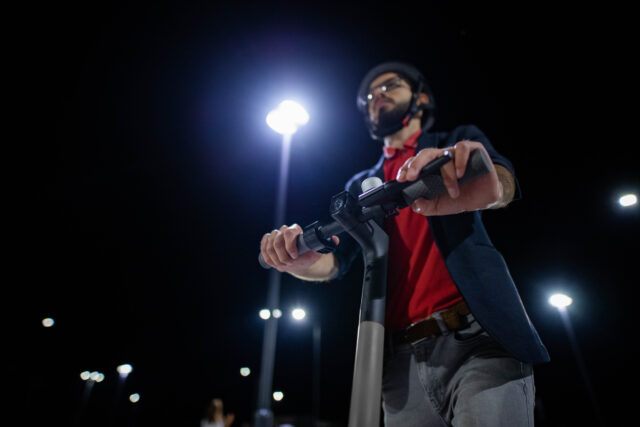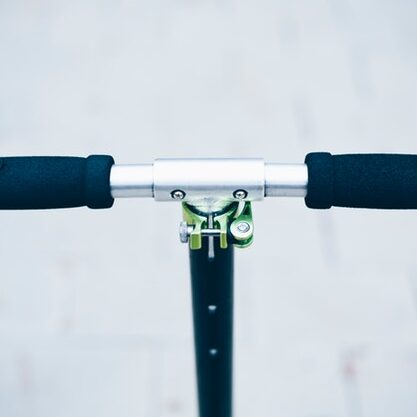Should Shared Micromobility Run 24/7?
by Kiran Herbert, Communications Manager
August 20, 2021
We examine the reasons two cities—Baltimore, Maryland, and Providence, Rhode Island—set different hours for folks using dockless scooters and bikes.

When shared micromobility first launched in Providence, Rhode Island, in 2018, hours were limited, with operations disabled between sunset and sunrise. Recognizing that those hours change throughout the year, however, the city eventually settled on 10 pm to 5 am as off hours, with all scooter and bike operators required to disable devices during that time.
“We know from regular bicycle use that very often, riders are not aware how invisible they are to drivers at night without extensive reflectors or lights,” says Alex Ellis, principle planner for the City of Providence, adding that electric scooter riders tend to have a lower level of experience and familiarity. “We felt that the lack of understanding about visibility at night would be even a greater issue with shared micromobility.”
Since alcohol use—more prevalent on weekend nights—and riding also don’t mix, the limited hours made sense. Add in the fact that nighttime ridership tends to be lower anyway and Providence feels like it’s made the best decision for its current shared micromobility environment.
“We’ve been pretty happy with scooters not being active at night,” says Ellis. “To my knowledge, we haven’t seen any collisions that are tied to it.”
When Baltimore, Maryland, launched a dockless scooter and electric bike pilot in 2018, it required operators to clear vehicles off the street every night. Realizing it was a huge lift, the city nixed the rule with shared micrmobility’s official launch and today, vehicles are available 24/7. For Meg Young, shared mobility coordinator at Baltimore City Department of Transportation, it was important for there to be parity amongst shared micromobility vehicles, transit services and private bicyclists. Less convincing were operators’ concerns regarding vandalism or irresponsible riding at night.
“I don’t think we should make prohibitive laws on things that have never happened,” says Young, noting that if companies monitor their fleets overnight and come back with issues, that’s a different story. “But we never want to prohibit things based on speculation.”
Equity was another driving force behind Young’s decision to maintain shared micromobility at all hours. Because transit services run less frequently at night and many who rely on it don’t have personal vehicles, it made sense to continue a reliable transportation option; for a worker engaged in shift work, 1 am may be prime commuting time. Equally important was ensuring that operators always maintained vehicles in Baltimore’s 12 equity zones, or parts of the city with historically marginalized populations.
“From our data, we can see that ridership doesn’t stop overnight,” says Young, adding that the city is currently conducting a survey of its equity zones to determine household vehicle availability. “In that sense, shared micromobility is such an amazing tool for access.”
In Providence, however, the data indicates that people aren’t primarily using the e-scooters to commute, likely because they tap out at 10 miles per hour (the data is still out on e-bikes, which were just reintroduced this past June). Instead, they’re often being used for short trips around the lunchtime hour (pre-COVID-19) and more recently, in the evenings. When asked about shift workers, Ellis admits that it’s something his team has discussed but that even during the pandemic, with more hospital workers using shared micromobility, there hasn’t been much of a demand.
“I certainly think we’re open to adjustments to the timing schedule,” says Ellis. “We actually just received a request to extend it in the evening by one hour.”
The ability to update regulation at any point is important when it comes to maintaining a system that’s flexible and responsive to the needs of its riders. In Fort Collins, Colorado, shared micromobility is restricted between the hours of 1 and 3 am, which although less restrictive than Providence might be more confusing. One of the hardest things about having restricted hours is making sure riders are aware of the rules, something that can also be said about things like riding and parking etiquette. As with most things shared micromobility, continuously soliciting feedback from current and potential customers helps build systems that work for everyone.
Does your city restrict hours of operation for different reasons? Do you feel strongly about maintaining a 24/7 system? Drop me a line with your thoughts on this issue or any other potential story ideas: kiran@peopleforbikes.org.



